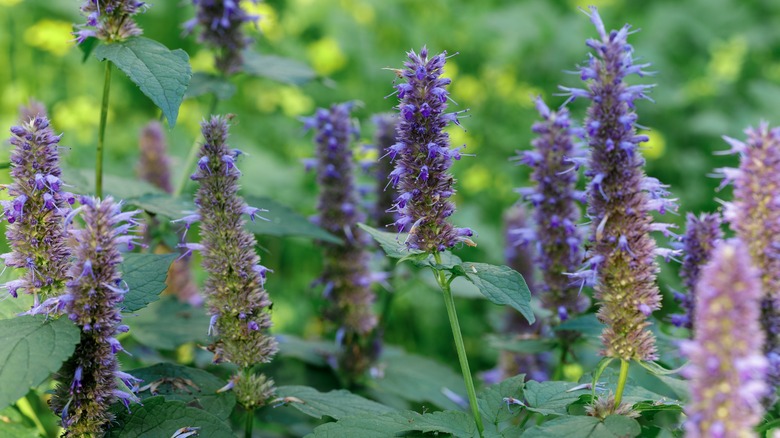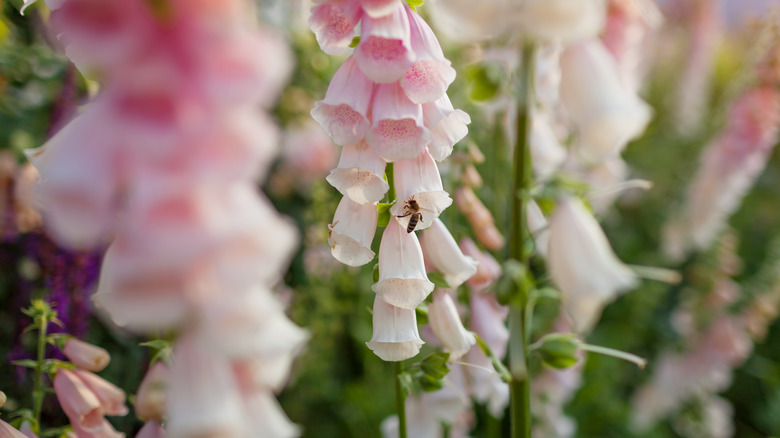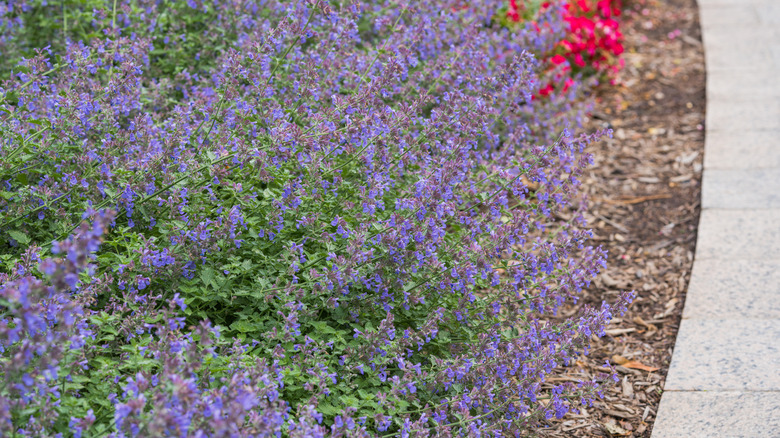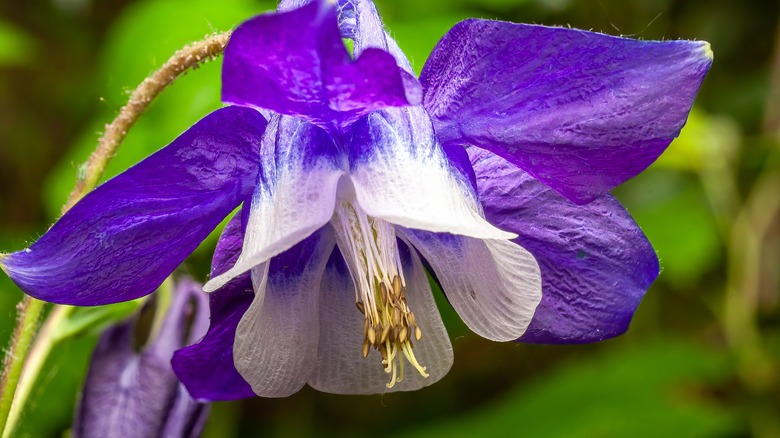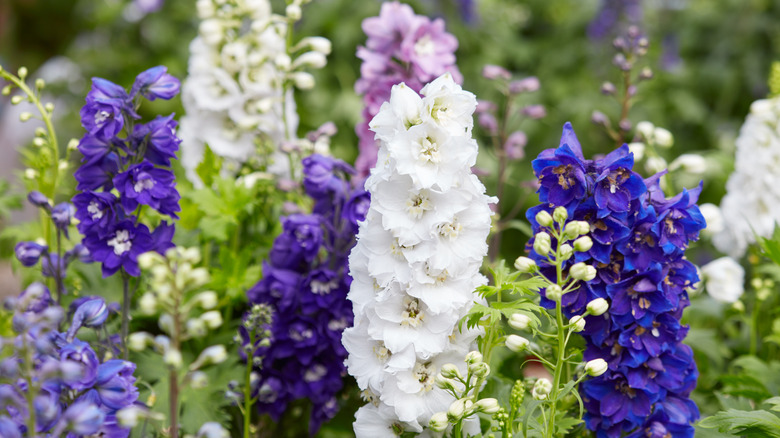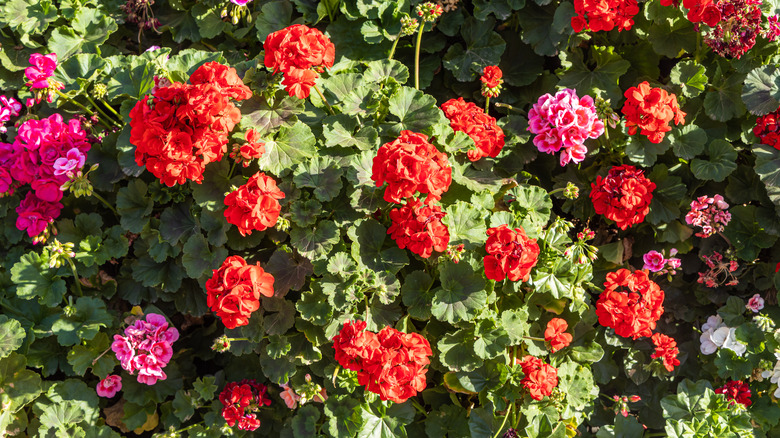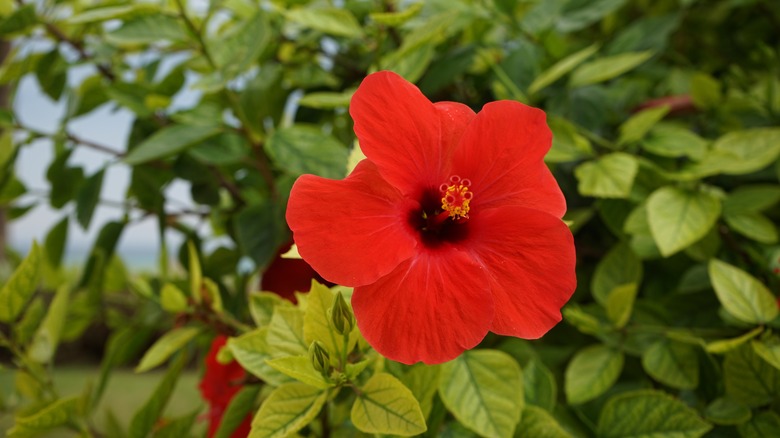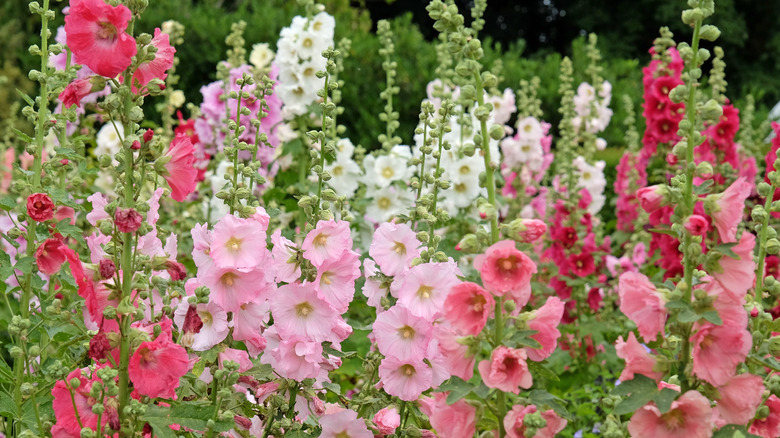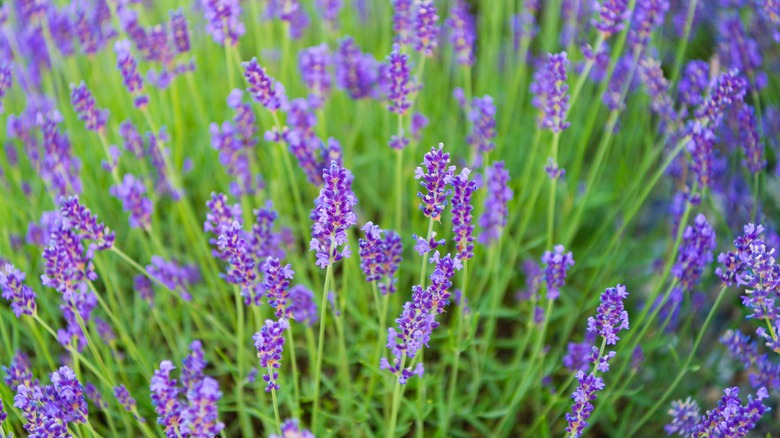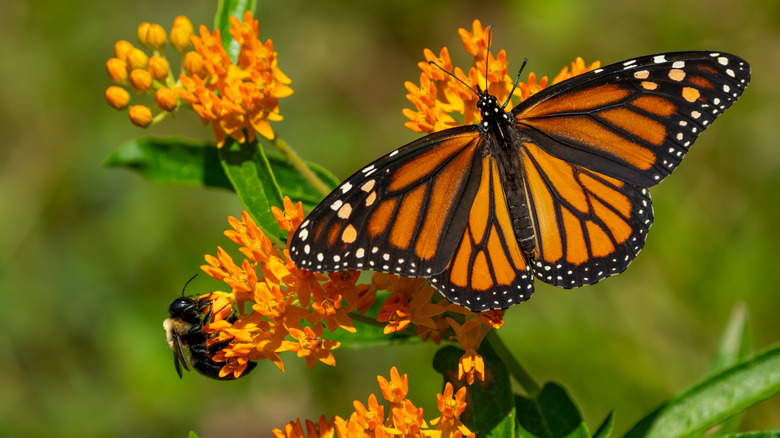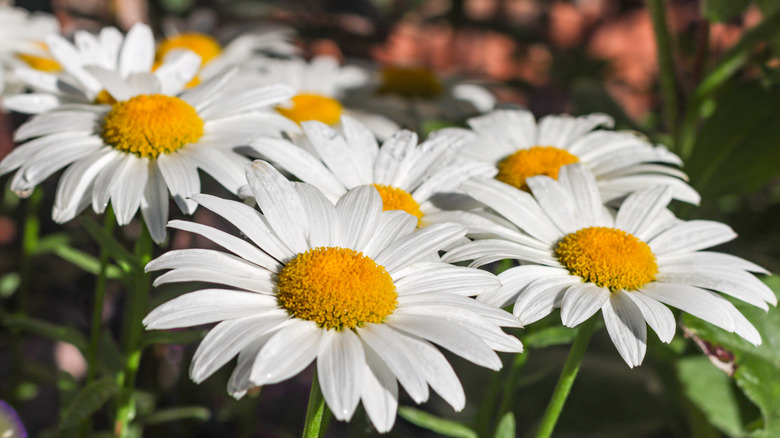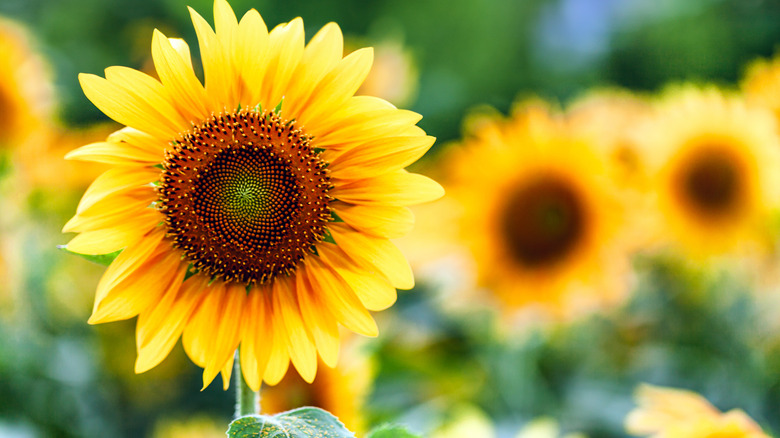19 Perennials That Are Better Off Being Planted In The Spring For Healthy Growth
It's hard to say goodbye to your plants at the end of the fall season, especially if you are dreaming of planting a colorful garden for year-round color. You may have heard that fall is the best time to get your perennials in the ground for spring blooms, and you're wondering if you can squeeze in more planting. While fall planting is optimal for some varieties, many perennials are better suited for spring planting to ensure healthy growth, even if they technically can be planted in the fall. A good rule of thumb is to plant mature perennials in the fall and seeds in the spring. Ultimately, however, it comes down to the type of flowers you are planting and the zone in which you are planting them.
When planting perennials in the spring, you may need to start them indoors, especially if you live in a colder climate. For optimal results, consider your local frost dates when planning your planting schedule. Varieties such as Anise Hyssop, Coneflower, Gaillardia, and Hollyhock should be started indoors at least eight weeks before the last frost date. However, some varieties should be started even earlier, such as daisies, Delphinium, and Heliopsis. These flowers should be started at least 10 weeks before the last frost date. They should also not be planted in the ground until the threat of frost has completely passed, which is typically about two weeks after the last frost date.
Anise Hyssop
Anise Hyssop (Agastache foeniculum) is an essential pollinator flower that plays a role in healthy ecosystems in North America, making it a valuable addition to your garden. It grows as a perennial in USDA zones four to eight. It should be planted in partial or full sun in the early spring to produce blooms in the first year from June to September. For spring planting, start seeds indoors approximately eight weeks before the last expected frost date. You could start them as late as five weeks before, but eight weeks gives them more time to establish roots. You can transplant them into the ground on the last frost date.
Barrenwort
If you're looking for a perennial that will provide the perfect groundcover for tree roots, barrenwort (Epimedium), also known as bishop's hat or fairy wings, is a great option that does best when planted in spring. It is generally used in border gardens in USDA zones five to eight. You can plant the rhizomes in the spring directly in the ground, but you may want to start them indoors if you live in a cooler climate. Refer to the planting instructions on your rhizome package for exact recommendations. Spring planting encourages healthy root establishment in the few years before flowering begins.
Beardtongue
Beardtongue (Penstemon digitalis) is a stunning perennial with tubular flowers that grow on long spikes in USDA zones three to eight. This is a great option for gardeners who are looking to attract hummingbirds to their yard. Starting the seeds indoors and transplanting them in the spring is great for promoting healthy growth. You can plant beardtongue in the ground any time after the risk of frost has passed. Start with a hole slightly larger than the root ball, cover the root with soil, and water well. You can add mulch to help retain moisture if needed, but you don't need to fertilize.
Catmint
Catmint (Nepeta), also known as catnip, is part of the mint family that grows as a perennial in USDA zones three to eight. While catmint is commonly known for being attractive to cats, it can offer a range of benefits in the garden, such as providing resistance to deer and attracting butterflies. For spring planting, you will generally want to get catmint started indoors about eight to 10 weeks before the last frost date. You can put the seedlings in the ground as soon as the last frost date arrives.
Columbine
You can bring the feeling of a wildflower meadow into your garden when you plant Columbine (Aquilegia), a perennial plant in the Ranunculaceae family. They generally grow in USDA zones three to eight, producing bell-shaped flowers in the spring and summer. While they usually only survive for a few seasons, they are well worth planting. Not only do they produce beautiful blooms, but they also attract songbirds and butterflies to your garden. You can start your columbine indoors about eight to 10 weeks before the last frost date.
Coneflower
If you want a perennial that has value in your flower garden and your medicine cabinet, coneflower (Echinacea) is one you don't want to overlook. The roots of echinacea are used in herbal medicines, but coneflower is also a fantastic addition to any flower garden in USDA zones three to eight. This is because it serves as a great companion plant, attracting pollinators and providing resistance to challenges like deer and drought. Start coneflower indoors about eight to 10 weeks before the last frost date and transplant them on the or after the last frost.
Delphinium
Delphinium, also known as Larskpur, is a stunning flowering plant in the Ranunculaceae family with over 500 different varieties. Some varieties are annual, but several perennial types grow in USDA zones three to nine. All of them are highly toxic to humans if ingested, so be careful when planting in gardens where small children play. Perennial Delphinium should be started indoors about 10 to 12 weeks before the last expected frost date. To make sure they have the healthiest growth for spring planting, plant them in the ground about two weeks after the last frost date.
Dianthus
Spring is the best time to plant dianthus, also called cheddar pinks or carnations. This is a fragrant perennial flower that grows in USDA zones four to nine. You can plant dianthus in containers to enjoy their fragrant scent almost anywhere, or you can sow them directly in the ground for an established flower garden. If you want to sow seeds directly in the ground, start planting when light frost is still possible. For indoor germination, start them about 10 to 12 weeks before the last frost date and transplant about one to two weeks after the threat of frost has passed.
Gaillardia
Gaillardia, also known as blanket flower, is a common flower garden perennial. It grows in USDA zones three to nine and is usually used to attract pollinators to border gardens. This is one of those perennials that can be planted in the fall (warm climates only), though it is better to wait until spring to transplant seedlings. For healthy spring planting, start seeds indoors about eight to 10 weeks before the last frost date. You can also find seedlings at garden centers that are ready to transplant as soon as the last frost date has passed, if you don't want to germinate them yourself.
Geraniums
Geraniums, also known as cranesbill, are a genus of perennial flowers that is commonly confused with Pelargonium, a genus of annual flowers that are very similar. Unlike Pelargoniums, Geraniums are hardy in USDA zones four to eight. They grow best when planted in full sun in the early spring after the last frost date. They will need at least one growing season to become established before they start producing blooms. The following season, you can expect to see blooms in the spring, summer, and fall.
Heliopsis
Heliopsis (Heliopsis helianthoides), also known as the false sunflower, is an herbaceous plant that can be grown in USDA zones three to nine. It's beautiful and grows best when planted in the spring, but you should consider how this sunflower variety can become a pest in the garden before fully committing to cultivating it. If you do decide to plant Heliopsis, start the seeds indoors about 10 to 12 weeks before the last frost date and transplant the seedlings a week or two later.
Hibiscus
Tropical perennials like hibiscus (Hibiscus syriacus) can also do better when planted in spring, rather than fall. While hibiscus doesn't technically grow in tropical environments, it provides a tropical element to gardens in USDA zones five to nine. One of the main reasons gardeners grow them, aside from their stunning blooms, is to attract hummingbirds and butterflies. When planting, make sure you have enough space for the mature plant, which can grow up to 12 feet tall and 10 feet wide. Start cuttings in a pot eight to 10 weeks before the last frost. You can place them in the ground about two weeks after the last frost date.
Hollyhock
Hollyhock (Alcea rosea) is technically a biennial, meaning it produces only foliage in year one and then acts as a perennial after year two. However, there are several varieties that are actually perennials that grow in USDA zones three to nine. When planting in the spring, you have a few options with your hollyhocks. First, you can sow the seed directly in the ground after the last frost date. Alternatively, you can start the seeds indoors and place them outside on or after the last frost date. If you choose to start them indoors, they should germinate for eight to 10 weeks before being transplanted outside.
Largeflower Tickseed
Largeflower tickseed (Coreopsis gladiata) is an herbaceous perennial that grows in USDA zones seven to 10 and produces yellow flowers on 1 to 2-foot-tall stems. In the spring, you will want to get your largeflower tickseed started indoors for healthy growth. They should grow for about eight to 10 weeks before you transplant them. The best time to move them outdoors is on the last frost date, but you can wait a bit later to make sure the threat of frost has passed. They grow particularly well near water in partial or full sun.
Lavender
Lavender (Lavandula angustifolia) is a well-known herbaceous perennial shrub in the mint family that is famous for its many uses, from aromatherapy to culinary applications. It does best when planted in partial or full sun in USDA zones five to nine. Generally, you won't want to start the plant from seeds yourself, although you can. It can take three months or more to germinate lavender seeds. Instead, most people will purchase seedlings from a local nursery or take cuttings from their own plants. For the healthiest lavender plants, wait to plant your seedling in the ground until soil temperatures are consistently above 60 degrees Fahrenheit.
Milkweed
If you want to bring butterflies to your garden, milkweed (Asclepias) is sure to create an appetizing buffet that will have them flocking in for a taste. While the name suggests it is a weed, milkweed is actually a flowering perennial in USDA zones three to nine that is known to be a staple for at least 12 species of butterflies and moths. It is also the main source of food for Monarch butterflies. In the spring, you can grow it from seeds or transplants. Either one should be put in the ground about two weeks after the last frost date.
Red Hot Poker
Another stunningly beautiful plant that will add color to your perennial garden while attracting pollinators is the red hot poker (Kniphofia), which grows in USDA zones five to eight. It grows from bulbs, which you can save and store in a moist environment at about 32 degrees Fahrenheit. Bulbs can be started in the fall, but they can be susceptible to freezing in the winter. Planting seedlings in the spring is generally recommended over fall planting. Wait until the threat of frost has completely passed, then plant the seedlings about one to three feet apart in a location with well-draining soil in partial or full sun.
Shasta Daisies
Shasta Daisies (Leucanthemum x superbum) are a long-blooming perennial that grows in USDA zones four to eight. Daisy varieties need a bit more time to germinate indoors before you can plant them outside in the spring. You should start them indoors at least 10 weeks before the last frost, but you can start as early as 12 weeks. After the last frost date, ensure the threat of frost has completely passed. It is best to wait another week or two before transplanting seedlings outside.
Sunflowers
If you are looking to plant perennial sunflowers (Helianthus), you will want to do this in the spring. If you plant sunflowers in the spring, you can still expect to see blooms later in the season in USDA zones six to nine. Like many other perennials that are planted in the spring, you should start your sunflowers indoors. Seeds should be sown between eight and 10 weeks before you plan to put them in the ground. They should be transplanted on or around the last frost date.

